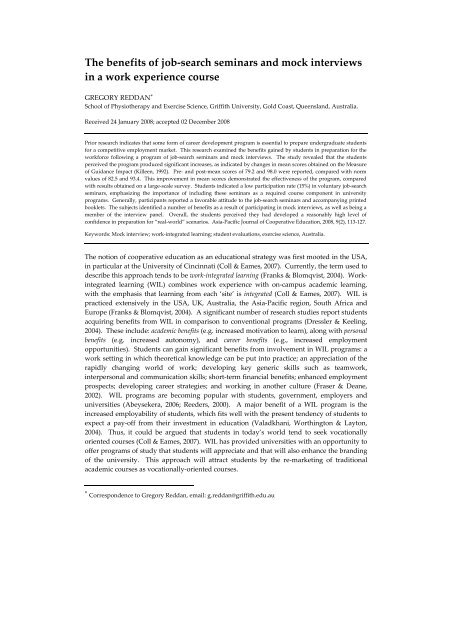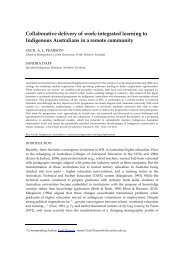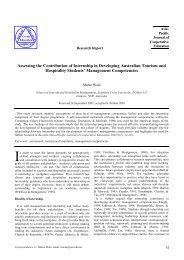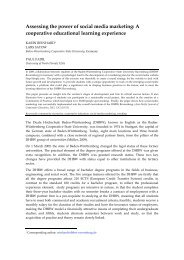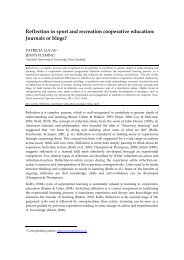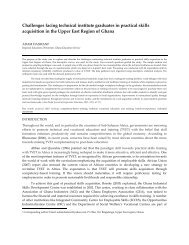The benefits of job-search seminars and mock interviews in a work ...
The benefits of job-search seminars and mock interviews in a work ...
The benefits of job-search seminars and mock interviews in a work ...
- No tags were found...
You also want an ePaper? Increase the reach of your titles
YUMPU automatically turns print PDFs into web optimized ePapers that Google loves.
Reddan – <strong>The</strong> Benefits <strong>of</strong> Job‐<strong>search</strong> Sem<strong>in</strong>ars <strong>and</strong> Mock InterviewsSELF‐EFFICACY<strong>The</strong> concept <strong>of</strong> self‐efficacy is def<strong>in</strong>ed by B<strong>and</strong>ura (1995) as the impact <strong>of</strong> how people feel,th<strong>in</strong>k <strong>and</strong> act <strong>in</strong> stressful situations that reflect accomplishments <strong>and</strong> personal development.People with low self‐efficacy typically hold negative thoughts about their achievements <strong>and</strong>accomplishments <strong>in</strong> certa<strong>in</strong> doma<strong>in</strong>s, <strong>and</strong> become anxious when discuss<strong>in</strong>g their expertise.Practic<strong>in</strong>g for situations such as be<strong>in</strong>g <strong>in</strong>terviewed for a <strong>job</strong> vacancy can help improve selfefficacy(Harchar, 2005). Self‐efficacy affects an <strong>in</strong>dividual’s choice <strong>of</strong> activity, environment,energy‐expenditure, persistence <strong>and</strong> thought patterns as well as their emotional reactions(Smith & Fouad, 1999). Self‐efficacy is dynamic <strong>and</strong> specific to particular areas <strong>of</strong> activity<strong>and</strong> thus is considered doma<strong>in</strong> specific although it <strong>in</strong>teracts with a person’s behavioral <strong>and</strong>contextual factors (Lent, Brown & Hackett, 1994; Sweeney & Twomey, 1997). WIL has beenshown to enhance self‐efficacy towards career development (Weaver‐Paquette, 1997).Fletcher (1989, 1990) suggests that WIL can enhance efficacious beliefs <strong>in</strong> three ways: enactivemastery (the ga<strong>in</strong><strong>in</strong>g <strong>of</strong> specific practical skills); observation <strong>of</strong> others; <strong>and</strong> verbal persuasion<strong>of</strong> others evaluat<strong>in</strong>g one’s performance.INTERVIEW PERFORMANCEMany students have little experience <strong>in</strong> be<strong>in</strong>g <strong>in</strong>terviewed for positions when they beg<strong>in</strong>seek<strong>in</strong>g <strong>work</strong> placements. Despite possess<strong>in</strong>g excellent resumes, students may fail to securea placement if they perform poorly dur<strong>in</strong>g pre‐placement <strong><strong>in</strong>terviews</strong> (Coll & Lay, 2001).Comprehensive, formal <strong><strong>in</strong>terviews</strong> represent a formidable challenge for many youngstudents. Pre‐plann<strong>in</strong>g for <strong><strong>in</strong>terviews</strong> has been reported to improve student confidence <strong>and</strong><strong>in</strong>terview performance, <strong>and</strong> is recommended as a strategy for improv<strong>in</strong>g prospects <strong>of</strong> a <strong>job</strong>placement. Strategies <strong>in</strong>clude prepar<strong>in</strong>g questions to ask employers, <strong>and</strong> anticipation <strong>of</strong>questions from employers at <strong>in</strong>terview time (Formo, 1995), <strong>and</strong> spend<strong>in</strong>g time polish<strong>in</strong>g<strong>in</strong>terpersonal skills or practic<strong>in</strong>g <strong>mock</strong> <strong><strong>in</strong>terviews</strong>. Coll <strong>and</strong> Lay (2001) report trial <strong><strong>in</strong>terviews</strong>improved self‐efficacy towards the pre‐placement <strong><strong>in</strong>terviews</strong> for two reasons. First, it enablesstudents to ga<strong>in</strong> an underst<strong>and</strong><strong>in</strong>g <strong>of</strong> the type <strong>of</strong> question they would encounter <strong>in</strong> an <strong>in</strong>depthformal <strong>in</strong>terview, <strong>and</strong> second, it affords them the opportunity to practice thearticulation <strong>of</strong> answers. In addition the trial <strong>in</strong>terview appears to have provided <strong>in</strong>formationabout the nature <strong>of</strong> the organization. <strong>The</strong>y suggested that students should conduct <strong>mock</strong><strong><strong>in</strong>terviews</strong> with peers, perhaps <strong>in</strong> a group session, mediated by a faculty member to providefeedback (Coll & Lay, 2001). Perform<strong>in</strong>g well at the <strong>in</strong>terview is one <strong>of</strong> the most importantsteps <strong>in</strong> successfully secur<strong>in</strong>g a <strong>job</strong>. While some students are comfortable <strong>in</strong> discuss<strong>in</strong>g <strong>and</strong>market<strong>in</strong>g themselves to potential employers, others may benefit from build<strong>in</strong>g confidence <strong>in</strong>their performance. Mock <strong><strong>in</strong>terviews</strong> provide students with the opportunity to practice<strong>in</strong>terview techniques <strong>and</strong> to experience be<strong>in</strong>g an <strong>in</strong>terviewer <strong>in</strong> a small group sett<strong>in</strong>g.<strong>The</strong> strategy <strong>of</strong> us<strong>in</strong>g a <strong>mock</strong> <strong>in</strong>terview experience before field <strong>work</strong> is relativelyunderstudied at the post‐secondary level <strong>and</strong> more re<strong>search</strong> is needed <strong>in</strong> this area (Harchar,2005). This paper exam<strong>in</strong>es the <strong>benefits</strong> provided by <strong>job</strong>‐<strong>search</strong> <strong>sem<strong>in</strong>ars</strong> <strong>and</strong> a <strong>mock</strong><strong>in</strong>terview <strong>in</strong> prepar<strong>in</strong>g students for the <strong>work</strong>force as part <strong>of</strong> a <strong>work</strong>‐<strong>in</strong>tegrated course <strong>in</strong>exercise science.Asia‐Pacific Journal <strong>of</strong> Cooperative Education, 2008, 9(2), 113‐127 115
Reddan – <strong>The</strong> Benefits <strong>of</strong> Job‐<strong>search</strong> Sem<strong>in</strong>ars <strong>and</strong> Mock InterviewsCASE STUDY CONTEXTGriffith University has several campuses located <strong>in</strong> Brisbane <strong>and</strong> the Gold Coast,Queensl<strong>and</strong>. Griffith University’s teach<strong>in</strong>g <strong>and</strong> learn<strong>in</strong>g programs aim to provideopportunities for students to acquire knowledge <strong>and</strong> skills that can be applied <strong>in</strong> thecommunity. Griffith aims to <strong>in</strong>clude <strong>work</strong>‐<strong>in</strong>tegrated learn<strong>in</strong>g <strong>in</strong> at least 70% <strong>of</strong> all degreeprograms by 2010 (Griffith University, 2006). Field Project B is an optional third year course<strong>in</strong> the Bachelor <strong>of</strong> Exercise Science program conducted at the Gold Coast campus. Normalenrolments <strong>in</strong> the course range from 30‐50 students out <strong>of</strong> a cohort <strong>of</strong> approximately 100.<strong>The</strong> rationale for <strong>in</strong>clud<strong>in</strong>g this course is to make students aware <strong>of</strong> the requirements <strong>of</strong> the<strong>in</strong>dustry they wish to enter <strong>and</strong> the <strong>work</strong><strong>in</strong>g environment <strong>of</strong> various organizations <strong>in</strong> whichthey may wish to seek employment. <strong>The</strong> course is designed to l<strong>in</strong>k <strong>and</strong> complement thestudent’s program <strong>of</strong> study by <strong>in</strong>troduc<strong>in</strong>g them to the <strong>work</strong> environment. <strong>The</strong> ma<strong>in</strong>purposes <strong>of</strong> this course are: (a) to provide students with <strong>work</strong> experience with<strong>in</strong> the <strong>in</strong>dustrythey may seek employment; (b) to <strong>in</strong>troduce students to various topics concern<strong>in</strong>g the <strong>work</strong>environment; <strong>and</strong> (c) to provide career plann<strong>in</strong>g procedures <strong>and</strong> <strong>job</strong> <strong>search</strong> skills tra<strong>in</strong><strong>in</strong>g.This course <strong>in</strong>cludes 13 two‐hour lecture/<strong>work</strong>shops <strong>in</strong> which students are <strong>in</strong>troduced topr<strong>of</strong>essional <strong>and</strong> personal techniques to assist them to ga<strong>in</strong> entry <strong>in</strong>to the <strong>work</strong>place <strong>and</strong> t<strong>of</strong>unction successfully once they are <strong>in</strong> the <strong>work</strong>place. <strong>The</strong> course is staff‐<strong>in</strong>tensive with <strong>in</strong>putfrom lecturers from the School <strong>of</strong> Physiotherapy <strong>and</strong> Exercise Science, Careers <strong>and</strong>Employment Services <strong>and</strong> relevant employer groups. Four staff members were <strong>in</strong>volved <strong>in</strong>each <strong>of</strong> the two‐hour <strong>mock</strong> <strong>in</strong>terview sessions.This particular re<strong>search</strong> focused on an evaluation <strong>of</strong> the perceived effectiveness <strong>of</strong> the <strong>job</strong><strong>search</strong>‐<strong>sem<strong>in</strong>ars</strong> <strong>and</strong> <strong>mock</strong> <strong><strong>in</strong>terviews</strong>. <strong>The</strong> <strong>sem<strong>in</strong>ars</strong> <strong>in</strong>cluded:• Development <strong>of</strong> resume/CV;• Effective <strong>job</strong> <strong>search</strong>;• Application letters;• Selection criteria; <strong>and</strong>• Job <strong><strong>in</strong>terviews</strong>.For the purpose <strong>of</strong> the <strong>mock</strong> <strong><strong>in</strong>terviews</strong>, students were organized <strong>in</strong>to groups <strong>of</strong> five or six(<strong>and</strong> sub‐groups <strong>of</strong> two or three). Each group was provided with a <strong>job</strong> advertisementrelevant to a graduate <strong>of</strong> the Bachelor <strong>of</strong> Exercise Science program. A staff member from theSchool <strong>of</strong> Physiotherapy <strong>and</strong> Exercise Science or the Careers <strong>and</strong> Employment Services wasallocated to each group. Students were required to construct appropriate <strong>in</strong>terviewquestions. Prior to the <strong><strong>in</strong>terviews</strong>, sub‐groups formed panels <strong>and</strong> organized questions withdirection from the allocated staff member. When the first sub‐group had been <strong>in</strong>terviewed,the panels swapped roles. Before the <strong>in</strong>terview commenced, the panel reviewed thestudent’s cover letter, CV <strong>and</strong> responses to selection criteria <strong>and</strong> made comments onfeedback sheets. Dur<strong>in</strong>g the <strong>in</strong>terview, panelists noted po<strong>in</strong>ts <strong>in</strong> relation to pr<strong>of</strong>essionalimage, communication skills <strong>and</strong> confidence. After all <strong><strong>in</strong>terviews</strong> had been completed,panelists discussed feedback with each student. Follow<strong>in</strong>g the <strong><strong>in</strong>terviews</strong> all staff membersforwarded a summary <strong>of</strong> their perceptions <strong>of</strong> the group’s strengths <strong>and</strong> weaknesses to thecourse convener. <strong>The</strong> follow<strong>in</strong>g week the convener presented these summaries to the classfor discussion.Asia‐Pacific Journal <strong>of</strong> Cooperative Education, 2008, 9(2), 113‐127 116
Reddan – <strong>The</strong> Benefits <strong>of</strong> Job‐<strong>search</strong> Sem<strong>in</strong>ars <strong>and</strong> Mock InterviewsRESEARCH METHODOLOGYRe<strong>search</strong> PurposeThis re<strong>search</strong> exam<strong>in</strong>ed the effectiveness <strong>of</strong> part <strong>of</strong> a <strong>work</strong>‐<strong>in</strong>tegrated learn<strong>in</strong>g course <strong>in</strong>prepar<strong>in</strong>g students for <strong><strong>in</strong>terviews</strong> related to real‐world positions <strong>in</strong> <strong>in</strong>dustries relevant totheir undergraduate studies <strong>in</strong> Exercise Science. <strong>The</strong> results will be used to improve theeffectiveness <strong>of</strong> Field Project B for future students. <strong>The</strong> re<strong>search</strong> <strong>in</strong>cluded five re<strong>search</strong>questions:1. How effective did students perceive the <strong>job</strong>‐<strong>search</strong> <strong>sem<strong>in</strong>ars</strong> <strong>and</strong> <strong>mock</strong> <strong><strong>in</strong>terviews</strong> <strong>in</strong> prepar<strong>in</strong>gthem for their future careers?2. Why did a majority <strong>of</strong> students not take advantage <strong>of</strong> the voluntary <strong>job</strong>‐<strong>search</strong> <strong>sem<strong>in</strong>ars</strong>,provided by the Careers <strong>and</strong> Employment Services at Griffith University, prior to thecommencement <strong>of</strong> Field Project B <strong>in</strong> the f<strong>in</strong>al semester <strong>of</strong> their degree program?3. What were the perceived strengths <strong>and</strong> weaknesses <strong>of</strong> the <strong>job</strong>‐<strong>search</strong> <strong>sem<strong>in</strong>ars</strong> <strong>and</strong> pr<strong>in</strong>tedbooklets accord<strong>in</strong>g to students? How might these sessions be improved?4. What perceived <strong>benefits</strong> did students ga<strong>in</strong> from be<strong>in</strong>g <strong>in</strong>terviewed, as well as be<strong>in</strong>g a member<strong>of</strong> the <strong>in</strong>terview panel? <strong>and</strong>5. How did students perceive the package <strong>of</strong> <strong>job</strong>‐<strong>search</strong> <strong>sem<strong>in</strong>ars</strong> <strong>and</strong> <strong>mock</strong> <strong><strong>in</strong>terviews</strong> preparedthem for “real‐world” <strong><strong>in</strong>terviews</strong>?Data Collection<strong>The</strong> re<strong>search</strong> was conducted us<strong>in</strong>g 33 third year Exercise Science students who made up theentire cohort <strong>in</strong> Field Project B at Griffith University <strong>in</strong> their f<strong>in</strong>al semester <strong>of</strong> study. <strong>The</strong><strong>in</strong>struments used for data collection <strong>in</strong>cluded the Measure <strong>of</strong> Guidance Impact (Killeen,1992), which was utilized before <strong>and</strong> after guidance (Appendix I). Follow<strong>in</strong>g the <strong>job</strong>‐<strong>search</strong><strong>sem<strong>in</strong>ars</strong> <strong>and</strong> <strong>mock</strong> <strong><strong>in</strong>terviews</strong>, students also responded to a self‐completion questionnairespecifically designed for this study (Appendix II).<strong>The</strong> Measure <strong>of</strong> Guidance Impact (MGI) was used as it is a valid <strong>and</strong> reliable <strong>in</strong>strument,which is completed before <strong>and</strong> after guidance related to career development. Its ma<strong>in</strong>purpose is to provide objective <strong>in</strong>formation to assist tra<strong>in</strong><strong>in</strong>g organizations <strong>and</strong> guidanceagencies to evaluate the effectiveness <strong>and</strong> monitor the learn<strong>in</strong>g outcomes <strong>of</strong> adult guidanceprograms <strong>and</strong> <strong>in</strong>terventions (National Foundation for Educational Re<strong>search</strong>, 1992). <strong>The</strong> MGImay be used to provide a general <strong>in</strong>dication <strong>of</strong> the value added through guidance services orto compare the value <strong>of</strong> different types <strong>of</strong> guidance <strong>in</strong> relation to their longer‐term economicoutcomes (Christophers et al., 1993). Evidence for the validity <strong>of</strong> the MGI has been providedthrough several sources. <strong>The</strong> theoretical formulation <strong>of</strong> the guidance process from which theitems with<strong>in</strong> the <strong>in</strong>strument were developed provides one type <strong>of</strong> evidence <strong>of</strong> validity. <strong>The</strong>methods used for item selection, particularly the use <strong>of</strong> a panel <strong>of</strong> judges, ensured that theitems truly reflected the issues <strong>of</strong> concern <strong>and</strong> represented the four areas <strong>of</strong> guidance. Aprevious test‐retest study provided additional evidence for the validity <strong>of</strong> the <strong>in</strong>strument(Christophers et al., 1993).Evidence related to the reliability <strong>of</strong> the MGI has been provided by two sources. First, clientsmade the same responses to the questions when given these items a week apart but with noguidance <strong>in</strong>terview. This demonstrated that the questions are consistently <strong>in</strong>terpreted eachtime <strong>and</strong> clients do not respond r<strong>and</strong>omly. Second, the items <strong>in</strong> the questionnaire tend tocorrelate with each other. A Cronbach Alpha coefficient <strong>of</strong> 0.89 <strong>in</strong>dicates good reliability,Asia‐Pacific Journal <strong>of</strong> Cooperative Education, 2008, 9(2), 113‐127 117
Reddan – <strong>The</strong> Benefits <strong>of</strong> Job‐<strong>search</strong> Sem<strong>in</strong>ars <strong>and</strong> Mock Interviewswhich <strong>in</strong>dicates substantial reliability especially for an <strong>in</strong>strument consist<strong>in</strong>g <strong>of</strong> 25 items.Longer <strong>in</strong>struments can produce higher measures <strong>of</strong> reliability (Christophers et al., 1993).<strong>The</strong>re are two forms <strong>of</strong> the MGI – Form 1 is used pre‐guidance <strong>and</strong> Form 2 post‐guidance.Each form conta<strong>in</strong>s 25 statements, for which clients are asked to record, on a scale <strong>of</strong> 1 to 5,the extent <strong>of</strong> their agreement. Thus, the maximum score that can be achieved is 125 (25 x 5).Average scores (norms) were developed as a result <strong>of</strong> a large‐scale pilot study <strong>in</strong>volv<strong>in</strong>g 807subjects. <strong>The</strong> statements are simply phrased <strong>and</strong> have been designed to be read by themajority <strong>of</strong> adults. <strong>The</strong> needs <strong>of</strong> those clients who are learn<strong>in</strong>g English have also beenconsidered <strong>in</strong> the construction <strong>of</strong> the statements. <strong>The</strong> learn<strong>in</strong>g areas addressed by the MGIare the four categories <strong>of</strong> guidance commonly used with<strong>in</strong> the guidance service <strong>and</strong>described by Killeen et al. (1992). <strong>The</strong>se areas are described as:• Decision mak<strong>in</strong>g;• Opportunity awareness;• Transition skills; <strong>and</strong>• Self awareness.<strong>The</strong> MGI provides an overall score for clients, demonstrat<strong>in</strong>g the extent <strong>of</strong> change that maybe attributed to the effect <strong>of</strong> the guidance they have received. This is achieved by measur<strong>in</strong>gthe level <strong>of</strong> career awareness the clients demonstrate when they commence a guidanceprogram, compared with the level they atta<strong>in</strong> follow<strong>in</strong>g the program. <strong>The</strong> <strong>in</strong>strument is<strong>in</strong>tended for use <strong>in</strong> agencies <strong>of</strong>fer<strong>in</strong>g a range <strong>of</strong> guidance services, from simple provision <strong>of</strong><strong>in</strong>formation to further career counsel<strong>in</strong>g. Form 1 <strong>of</strong> the MGI was adm<strong>in</strong>istered dur<strong>in</strong>g thefirst lecture <strong>of</strong> the course, while Form 2 <strong>of</strong> the MGI was adm<strong>in</strong>istered after the <strong>job</strong> <strong>search</strong><strong>sem<strong>in</strong>ars</strong>, <strong>mock</strong> <strong><strong>in</strong>terviews</strong> <strong>and</strong> feedback sessions had been completed.Students also completed a two‐page questionnaire to allow them to answer freely <strong>and</strong>expla<strong>in</strong> their perceptions, suggestions <strong>and</strong> experiences. <strong>The</strong> re<strong>search</strong>er <strong>and</strong> a counselor fromthe Careers <strong>and</strong> Employment Services developed the questionnaire, which consisted <strong>of</strong> shortanswer questions focus<strong>in</strong>g on several different aspects <strong>of</strong> the program. Some questions wereclosed to elicit specific <strong>in</strong>formation <strong>and</strong> rat<strong>in</strong>gs, while other questions were open to allowstudents to provide personal op<strong>in</strong>ions on the effectiveness <strong>of</strong> the program <strong>and</strong> makesuggestions with regards to possible future improvements.RESEARCH FINDINGS<strong>The</strong> re<strong>search</strong> f<strong>in</strong>d<strong>in</strong>gs are reported here us<strong>in</strong>g the five re<strong>search</strong> questions as head<strong>in</strong>gs.How effective did the students perceive the <strong>job</strong>‐<strong>search</strong> <strong>sem<strong>in</strong>ars</strong> <strong>and</strong> <strong><strong>in</strong>terviews</strong> <strong>in</strong> prepar<strong>in</strong>g them forfuture careers?Form 1 <strong>of</strong> the MGI was adm<strong>in</strong>istered <strong>in</strong> the first lecture <strong>of</strong> the course. Mean (± SD) scoresobta<strong>in</strong>ed were 79.2 ± 13.5 for Griffith students compared with a norm value <strong>of</strong> 82.5 ± 13.0,<strong>in</strong>dicat<strong>in</strong>g the subjects were slightly below average <strong>in</strong> relation to their read<strong>in</strong>ess for the<strong>work</strong>force. However, scores on Form 2 (conducted follow<strong>in</strong>g the series <strong>of</strong> <strong>in</strong>formationsessions <strong>and</strong> <strong><strong>in</strong>terviews</strong>) demonstrated a mean <strong>of</strong> 98.0 ± 8.6 compared with a norm <strong>of</strong> 93.4 ±11.2. <strong>The</strong> post‐test MGI score was significantly greater (p
Reddan – <strong>The</strong> Benefits <strong>of</strong> Job‐<strong>search</strong> Sem<strong>in</strong>ars <strong>and</strong> Mock InterviewsSubjects with <strong>in</strong>itially low scores on the MGI would appear to have greater potential forimprovement follow<strong>in</strong>g guidance than those with relatively high basel<strong>in</strong>e scores. <strong>The</strong>sepo<strong>in</strong>ts need to be taken <strong>in</strong>to account when <strong>in</strong>terpret<strong>in</strong>g the results <strong>of</strong> the MGI. A usefulmethod <strong>of</strong> <strong>in</strong>terpret<strong>in</strong>g the <strong>in</strong>formation is by analyz<strong>in</strong>g the performance <strong>of</strong> subjects whosebasel<strong>in</strong>e falls with<strong>in</strong> certa<strong>in</strong> b<strong>and</strong>s. <strong>The</strong> MGI uses three b<strong>and</strong>s for categoriz<strong>in</strong>g subjects.B<strong>and</strong> 1 consists <strong>of</strong> those subjects whose basel<strong>in</strong>e scores fall between 25 <strong>and</strong> 80 (out <strong>of</strong> apossible 125). B<strong>and</strong> 2 consists <strong>of</strong> those subjects who have scores between 81 <strong>and</strong> 90, whilstB<strong>and</strong> 3 consists <strong>of</strong> those subjects who score between 91 <strong>and</strong> 125. “<strong>The</strong> use <strong>of</strong> b<strong>and</strong><strong>in</strong>g<strong>in</strong>creases the sensitivity <strong>of</strong> the <strong>in</strong>strument to detect changes, while at the same timedecreas<strong>in</strong>g the <strong>in</strong>fluence <strong>of</strong> a few extreme scores which could skew the results” (NationalFoundation for Educational Re<strong>search</strong>, 1992, p. 8).In the present study, 42% <strong>of</strong> subjects were categorized as B<strong>and</strong> 1 (compared with a norm <strong>of</strong>43%), whereas 40% scored with<strong>in</strong> B<strong>and</strong> 2 (compared with a norm <strong>of</strong> 30%), <strong>and</strong> 18% wereplaced <strong>in</strong> B<strong>and</strong> 3 (compared with a norm <strong>of</strong> 27%). <strong>The</strong> average changes <strong>in</strong> po<strong>in</strong>ts for subjectswith<strong>in</strong> each b<strong>and</strong> <strong>in</strong> this study were: 28.4 for B<strong>and</strong> 1; 12.5 for B<strong>and</strong> 2; <strong>and</strong> 10.0 for B<strong>and</strong> 3.<strong>The</strong> correspond<strong>in</strong>g norms for the large‐scale pilot were 17 for B<strong>and</strong> 1, 9 for B<strong>and</strong> 2 <strong>and</strong> 4 forB<strong>and</strong> 3. <strong>The</strong>se differences <strong>in</strong>dicate the Griffith program is produc<strong>in</strong>g considerable <strong>benefits</strong>with<strong>in</strong> all three b<strong>and</strong>s <strong>in</strong> the study group.Why did a majority <strong>of</strong> students not take advantage <strong>of</strong> the voluntary <strong>job</strong> <strong>search</strong> <strong>sem<strong>in</strong>ars</strong> provided bythe Careers <strong>and</strong> Employment Services at Griffith University prior to the commencement <strong>of</strong> FieldProject B <strong>in</strong> the f<strong>in</strong>al semester <strong>of</strong> the degree program?<strong>The</strong> voluntary <strong>job</strong>‐<strong>search</strong> <strong>sem<strong>in</strong>ars</strong> are available to all university students on severaloccasions throughout the year. Only five students (15%) enrolled <strong>in</strong> the voluntary<strong>in</strong>formation sessions prior to the commencement <strong>of</strong> Field Project B, while 28 (85%) did nottake advantage <strong>of</strong> these sessions. <strong>The</strong> most common reasons for not attend<strong>in</strong>g were (number<strong>of</strong> students shown <strong>in</strong> brackets):• Was not aware <strong>of</strong> the program (18);• No need (5);• Lack <strong>of</strong> time (4); <strong>and</strong>• On holiday (2).Other <strong>in</strong>dividual reasons provided were “laz<strong>in</strong>ess”; “didn’t see relevance”; “unaware <strong>of</strong>content”; “focused on study”; “<strong>in</strong>jury”; “pay<strong>in</strong>g house <strong>of</strong>f”; <strong>and</strong> “no‐one to go with”. Itwould appear that different market<strong>in</strong>g strategies should be used by the Careers <strong>and</strong>Employment Service <strong>and</strong> the School <strong>of</strong> Physiotherapy <strong>and</strong> Exercise Science to ensure that agreater number <strong>of</strong> students are aware <strong>of</strong> <strong>and</strong> actively encouraged to participate <strong>in</strong> thisbeneficial voluntary program to <strong>in</strong>crease student awareness <strong>of</strong> the importance <strong>of</strong> careerdevelopment. <strong>The</strong> low participation rate <strong>in</strong> the voluntary <strong>sem<strong>in</strong>ars</strong> has emphasized theimportance <strong>of</strong> <strong>in</strong>clud<strong>in</strong>g these <strong>sem<strong>in</strong>ars</strong> as a required component <strong>of</strong> Field Project B to ensurethat all students have been exposed to this <strong>in</strong>formation which is vitally important for theircareer development.What were the perceived strengths <strong>and</strong> weaknesses <strong>of</strong> the <strong>job</strong>‐<strong>search</strong> <strong>sem<strong>in</strong>ars</strong> <strong>and</strong> pr<strong>in</strong>ted bookletsaccord<strong>in</strong>g to students? How might these sessions be improved?<strong>The</strong> subjects were asked to rate the effectiveness <strong>of</strong> the <strong>in</strong>formation sessions <strong>and</strong> pr<strong>in</strong>tedbooklets on a scale <strong>of</strong> 1‐10 (1 be<strong>in</strong>g very poor <strong>and</strong> 10 be<strong>in</strong>g outst<strong>and</strong><strong>in</strong>g). <strong>The</strong> rat<strong>in</strong>gs werequite positive with mean scores rang<strong>in</strong>g from 7.1 to 8.2. Students suggested that the bookletsAsia‐Pacific Journal <strong>of</strong> Cooperative Education, 2008, 9(2), 113‐127 119
Reddan – <strong>The</strong> Benefits <strong>of</strong> Job‐<strong>search</strong> Sem<strong>in</strong>ars <strong>and</strong> Mock Interviewsfor the Resume/CV <strong>and</strong> Effective Job Search were more useful than the respective<strong>in</strong>formation sessions. <strong>The</strong> students <strong>in</strong>dicated a number <strong>of</strong> strengths <strong>of</strong> the <strong>in</strong>formationsessions. <strong>The</strong> most frequent responses were:• Information provided (6);• Breadth <strong>of</strong> material (6);• Booklets (5);• How to get to the <strong>in</strong>terview stage (4);• What the employer is look<strong>in</strong>g for (3);• Increased awareness <strong>of</strong> aspects <strong>in</strong>volved <strong>in</strong> <strong>job</strong> applications (2);• How to improve <strong>in</strong>terview performance (2);• Importance <strong>of</strong> net<strong>work</strong><strong>in</strong>g (2); <strong>and</strong>• Relat<strong>in</strong>g to the real world (2).Generally students demonstrated a favorable attitude to the <strong>in</strong>formation sessions. Us<strong>in</strong>g thesame 1‐10 scale, the students were asked to rate the effectiveness <strong>of</strong> the <strong>in</strong>formation sessions<strong>in</strong> prepar<strong>in</strong>g them for the <strong>in</strong>terview. <strong>The</strong> results suggested the majority <strong>of</strong> students werepositive about the experience with a mean response <strong>of</strong> 8.0 with a range from 6 to10. Inresponse to their perception <strong>of</strong> weaknesses <strong>of</strong> the <strong>in</strong>formation sessions, 14 subjects (42%)suggested that there were no weaknesses. Other common responses were:• Not specific to a degree <strong>in</strong> Exercise Science (5);• Could have been compressed (3);• Some sections repetitive (3);• Too brief (2);• Too rushed (2);• Should have been provided <strong>in</strong> first year (2); <strong>and</strong>• Need to provide more active participation – more <strong>in</strong>terview practice (2).Suggestions were sought <strong>in</strong> regards to the improvement <strong>of</strong> the <strong>in</strong>formation sessions. Some10students <strong>in</strong>dicated no changes were necessary, while other common responses were “need toprovide more examples relevant to Exercise Science” (5), “spread over more sessions” (4),“employers from <strong>work</strong>place should be <strong>in</strong>volved <strong>in</strong> <strong><strong>in</strong>terviews</strong>” (2), <strong>and</strong> “use <strong>job</strong> <strong>search</strong>eng<strong>in</strong>es to f<strong>in</strong>d a <strong>job</strong> we would like to apply for <strong>and</strong> submit a week before <strong>in</strong>terview” (2).What perceived <strong>benefits</strong> did students ga<strong>in</strong> from be<strong>in</strong>g <strong>in</strong>terviewed, as well as be<strong>in</strong>g a member <strong>of</strong> the<strong>in</strong>terview panel?<strong>The</strong> students <strong>in</strong>dicated a number <strong>of</strong> <strong>benefits</strong> were provided through be<strong>in</strong>g <strong>in</strong>terviewed. <strong>The</strong>most common <strong>benefits</strong> suggested were “realize weaknesses – what I need to <strong>work</strong> on” (5),“practice <strong>in</strong> answer<strong>in</strong>g questions” (4), “how to prepare” (3), “experience” (3), “actualquestions I would be asked”, “knowledge <strong>of</strong> personal strengths” (3), “improved selfconfidence”(3) <strong>and</strong> “ability to h<strong>and</strong>le stress” (3). Students suggested that they also ga<strong>in</strong>edsignificantly from be<strong>in</strong>g a member <strong>of</strong> the <strong>in</strong>terview panel. <strong>The</strong> more frequent responses<strong>in</strong>cluded:• What the <strong>in</strong>terviewers are look<strong>in</strong>g for (8);• What it’s like from the other side – what looks good <strong>and</strong> what doesn’t (6);• Importance <strong>of</strong> body language (4);• Importance <strong>of</strong> eye contact (3);• Prepar<strong>in</strong>g responses before answer<strong>in</strong>g (2);• Possible questions which might be asked (2); <strong>and</strong>• Appropriate way to respond to questions (2).Asia‐Pacific Journal <strong>of</strong> Cooperative Education, 2008, 9(2), 113‐127 120
Reddan – <strong>The</strong> Benefits <strong>of</strong> Job‐<strong>search</strong> Sem<strong>in</strong>ars <strong>and</strong> Mock InterviewsHow did students perceive the <strong>job</strong> <strong>search</strong> <strong>sem<strong>in</strong>ars</strong> <strong>and</strong> <strong>mock</strong> <strong><strong>in</strong>terviews</strong> prepared them for “realworld”scenarios?<strong>The</strong> most common reply related to underst<strong>and</strong><strong>in</strong>g the importance <strong>of</strong> preparation (6). Otherfrequent responses <strong>in</strong>cluded “demonstrat<strong>in</strong>g what employers are look<strong>in</strong>g for” (4), “providedexperience” (4), “know<strong>in</strong>g what to expect” (4), “improved confidence” (3), “gave mepractice” (2) <strong>and</strong> “provided sufficient background knowledge for future applications” (2).Subjects were asked to rate their level <strong>of</strong> confidence for a future <strong>in</strong>terview on the 1‐10 scale (1<strong>in</strong>dicat<strong>in</strong>g a very low level <strong>and</strong> 10 a very high level). <strong>The</strong> mean <strong>of</strong> the rat<strong>in</strong>gs was 7.8 with arange <strong>of</strong> 6 to 10, demonstrat<strong>in</strong>g a reasonably high level <strong>of</strong> confidence with<strong>in</strong> the cohort <strong>in</strong>preparation for “real‐world” scenarios.<strong>The</strong> follow<strong>in</strong>g suggestions were provided by students <strong>in</strong> regards to the organization <strong>of</strong> FieldProject B for future years:• <strong>The</strong> <strong>job</strong>‐<strong>search</strong> <strong>sem<strong>in</strong>ars</strong> should be spread over three weeks rather than two <strong>in</strong> order to allowstudents to fully explore the material, develop their CV <strong>and</strong> ga<strong>in</strong> more knowledge relevant tothe <strong>job</strong> application process;• More examples need to be provided <strong>of</strong> ways <strong>in</strong> which students can demonstrate their abilitiesto meet selection criteria with reference to scenarios <strong>in</strong> Exercise Science;• Students need to be more actively engaged <strong>in</strong> the learn<strong>in</strong>g processes <strong>in</strong> the <strong>job</strong>‐<strong>search</strong><strong>sem<strong>in</strong>ars</strong>. Small group activities <strong>and</strong> scenarios should be <strong>in</strong>cluded to create more enthusiasmfor learn<strong>in</strong>g;• More practice should be provided <strong>in</strong> m<strong>in</strong>i‐<strong>in</strong>terview situations to allow students to feelcomfortable <strong>in</strong> the <strong>mock</strong> <strong>in</strong>terview scenario <strong>and</strong> future “real‐world” <strong><strong>in</strong>terviews</strong>;• It would be more relevant <strong>and</strong> motivat<strong>in</strong>g if students were allowed to select a <strong>job</strong> fromappropriate <strong>job</strong> <strong>search</strong> eng<strong>in</strong>es for which they would like to apply, rather than be<strong>in</strong>g allocateda position suitable for an Exercise Science graduate;• More time should be allowed for discussion <strong>of</strong> feedback <strong>and</strong> self‐reflection to allow students toanalyze <strong>and</strong> evaluate their performance, identify aspects requir<strong>in</strong>g improvement <strong>and</strong> developplans to reach personal goals <strong>and</strong> st<strong>and</strong>ards; <strong>and</strong>• A second formal <strong>in</strong>terview should be made available on a voluntary basis to provide studentswith another opportunity to practice <strong>in</strong> a <strong>mock</strong> situation before enter<strong>in</strong>g the “real world”.IMPLICATIONS AND RECOMMENDATIONS<strong>The</strong> results <strong>of</strong> this re<strong>search</strong> clearly identify positive trends <strong>in</strong> students’ perceptions <strong>in</strong> regardsthe <strong>benefits</strong> <strong>of</strong> this program. Further re<strong>search</strong> <strong>in</strong>volv<strong>in</strong>g students from other faculties with<strong>in</strong>the university would provide more conclusive evidence. Although the <strong>job</strong> <strong>search</strong> <strong>sem<strong>in</strong>ars</strong>were provided on a voluntary basis to all students prior to the commencement <strong>of</strong> FieldProject B, the majority did not take advantage <strong>of</strong> the program for a variety <strong>of</strong> reasons. Thus,it would seem appropriate for all students at Griffith University to be exposed to thesefeatures <strong>of</strong> <strong>work</strong>‐<strong>in</strong>tegrated learn<strong>in</strong>g as part <strong>of</strong> their formal academic program <strong>of</strong> study.Given that scenario, specific Schools <strong>and</strong> Faculties could design learn<strong>in</strong>g experiences so thatthey are relevant to their particular students rather than the generic approach used whenstudents voluntarily attend sessions <strong>of</strong>fered by the Careers <strong>and</strong> Employment Services. Allstudents would ga<strong>in</strong> from experience <strong>of</strong> the <strong>in</strong>terview process <strong>in</strong> preparation for the<strong>work</strong>force. This type <strong>of</strong> course would seem best placed prior to the f<strong>in</strong>al year <strong>of</strong> study toallow students sufficient time to apply the <strong>in</strong>formation to their personal circumstances <strong>and</strong>improve their skills before emerg<strong>in</strong>g from the “protected cocoon” <strong>of</strong> university.Asia‐Pacific Journal <strong>of</strong> Cooperative Education, 2008, 9(2), 113‐127 121
Reddan – <strong>The</strong> Benefits <strong>of</strong> Job‐<strong>search</strong> Sem<strong>in</strong>ars <strong>and</strong> Mock InterviewsREFERENCESAbeysekera, I. (2006) Issues relat<strong>in</strong>g to design<strong>in</strong>g a <strong>work</strong>‐<strong>in</strong>tegrated learn<strong>in</strong>g program <strong>in</strong> anundergraduate account<strong>in</strong>g degree program <strong>and</strong> its implications for the curriculum. Asia‐Pacific Journal<strong>of</strong> Cooperative Education, 7(1), 7‐15.B<strong>and</strong>ura, A.J. (Ed.). (1995). Self‐efficacy <strong>in</strong> chang<strong>in</strong>g societies. Cambridge, UK: Cambridge University Press.Beard, C., & Wilson, J.P. (2002). <strong>The</strong> power <strong>of</strong> experiential learn<strong>in</strong>g: A h<strong>and</strong>book for tra<strong>in</strong>ers <strong>and</strong> educators.London: Kogan Page.Christophers, U., Stoney, S., Whetton, C., L<strong>in</strong>es, A., & Kendall, L. (1993). Measure <strong>of</strong> guidance impact: Usermanual. W<strong>in</strong>dsor, UK: National Foundation for Educational Re<strong>search</strong>‐Nelson Publish<strong>in</strong>g Company.Coll, R.K. & Eames, C. (2007). Learn<strong>in</strong>g science <strong>and</strong> technology through cooperative education. Asia‐Pacific Journal <strong>of</strong> Cooperative Education, 8(2), 131‐147.Coll, R.K. & Lay, M. (2001). Us<strong>in</strong>g trial <strong><strong>in</strong>terviews</strong> to enhance student self‐efficacy towards preplacement<strong><strong>in</strong>terviews</strong>. Journal <strong>of</strong> Cooperative Education, 36(3), 25‐36.Coll, R.K., Zegwaard, K. & Lay, M. (2001). <strong>The</strong> <strong>in</strong>fluence <strong>of</strong> cooperative education on student perceptions<strong>of</strong> their ability <strong>in</strong> practical science. Journal <strong>of</strong> Cooperative Education, 36(3), 58‐72.Council on Higher Education. (2001). A new academic policy for programmes <strong>and</strong> qualifications <strong>in</strong> highereducation, a discussion document. Pretoria, South Africa: CHE.Doherty, N., V<strong>in</strong>ey, C., & Adamson, S. (1997). Rhetoric or reality: Shifts <strong>in</strong> graduate career management?Career Development International, 1(7), 34‐41.Dressler, S., & Keel<strong>in</strong>g, A.E. (2004). Student <strong>benefits</strong> <strong>of</strong> cooperative education. In R.K. Coll & C. Eames(Eds.), International h<strong>and</strong>book for cooperative education: An <strong>in</strong>ternational perspective <strong>of</strong> the theory, re<strong>search</strong><strong>and</strong> practice <strong>of</strong> <strong>work</strong>‐<strong>in</strong>tegrated learn<strong>in</strong>g (pp. 217‐236). Boston: World Association for CooperativeEducation.Duignan, J. (2002). Undergraduate <strong>work</strong> placement <strong>and</strong> academic performance: Fail<strong>in</strong>g by do<strong>in</strong>g. In A.Goody, J. Herr<strong>in</strong>gton & M. Northcote (Eds.), Proceed<strong>in</strong>gs <strong>of</strong> the Annual Higher Education Re<strong>search</strong> &Development Society Conference (pp. 214‐221). HERDSA.Fallows, S., & Steven, C. (2000). Build<strong>in</strong>g employability skills <strong>in</strong>to the higher education curriculum: Auniversity‐wide <strong>in</strong>itiative. Education & Tra<strong>in</strong><strong>in</strong>g, 42(2), 75‐82.Fletcher, J. (1989), Student outcomes: What do we know, <strong>and</strong> how do we know it? Journal <strong>of</strong> CooperativeEducation, 26(1), 26‐38.Fletcher, J. (1990). Self‐esteem <strong>and</strong> cooperative education: A theoretical frame<strong>work</strong>. Journal <strong>of</strong> CooperativeEducation, 26(3), 41‐55.Folsom, B., Reardon, R., & Lee, D. (2005). <strong>The</strong> effects <strong>of</strong> college career courses on learner outputs <strong>and</strong> outcomes:Technical report No. 26 Revised. <strong>The</strong> Center for the Study <strong>of</strong> Technology <strong>in</strong> Counsel<strong>in</strong>g <strong>and</strong> CareerDevelopment. Tallahassee, FL: Florida State University.Formo, D.M. (1995, March). Become literate <strong>in</strong> the employment l<strong>in</strong>e: Graduate students’ strategies for <strong>job</strong>placement. Paper presented at the annual meet<strong>in</strong>g <strong>of</strong> the Conference on College Compositions <strong>and</strong>Communication. Wash<strong>in</strong>gton, DC.Franks, P. & Blomqvist, O. (2004). <strong>The</strong> World Association for Coopertaive Education: <strong>The</strong> global net<strong>work</strong>that fosters <strong>work</strong>‐<strong>in</strong>tegrated learn<strong>in</strong>g. In R.K. Coll & C. Eames, (Eds.), International h<strong>and</strong>book forcooperative education: An <strong>in</strong>ternational perspective <strong>of</strong> the theory, re<strong>search</strong> <strong>and</strong> practice <strong>of</strong> <strong>work</strong>‐<strong>in</strong>tegratedlearn<strong>in</strong>g (pp. 283‐289). Boston: World Association for Cooperative Education.Fraser, S., & Deane, E. (2002). Gett<strong>in</strong>g bench scientists to be <strong>work</strong>bench. In A. Fern<strong>and</strong>ez (Ed.),Proceed<strong>in</strong>gs <strong>of</strong> the UniServe Science Scholarly Inquiry Symposium (pp.38‐43). Sydney: University <strong>of</strong>Sydney.Griffith University. (2006). Strategic Plan 2006‐2010. Brisbane: Australia: Office for CommunityPartnerships.Harchar, R. (2005). Mock <strong>in</strong>terview strategy: An action re<strong>search</strong> study <strong>of</strong> adm<strong>in</strong>istrator <strong>and</strong> teacherc<strong>and</strong>idates’ preparation for <strong>in</strong>terview field experience. Journal <strong>of</strong> Scholarship <strong>of</strong> Teach<strong>in</strong>g <strong>and</strong> Learn<strong>in</strong>g,5(1), 35‐48.Higher Education Fund<strong>in</strong>g Council for Engl<strong>and</strong>. (2006). Towards a strategy for <strong>work</strong>place learn<strong>in</strong>g.Report by Centre for Higher Education Re<strong>search</strong> <strong>and</strong> Information <strong>and</strong> KPMG. London: HEFCE.Asia‐Pacific Journal <strong>of</strong> Cooperative Education, 2008, 9(2), 113‐127 122
Reddan – <strong>The</strong> Benefits <strong>of</strong> Job‐<strong>search</strong> Sem<strong>in</strong>ars <strong>and</strong> Mock InterviewsKilleen, J. (1992). <strong>The</strong> client review questionnaire. London: Department <strong>of</strong> Employment.Killeen, J., White, M., & Watts, A.G. (1992). <strong>The</strong> economic value <strong>of</strong> careers guidance. London: PSI <strong>in</strong>association with NICEC.Lau, A., & Pang, M. (2000). Career strategies to strengthen graduate employees’ employment position <strong>in</strong>the Hong Kong labour market. Education <strong>and</strong> Tra<strong>in</strong><strong>in</strong>g, 42(3), 135‐149.Lent, R.W., Brown, S.D., & Hackett, G. (1994). Toward aunify<strong>in</strong>g social cognitive theory <strong>of</strong> career <strong>and</strong>academic <strong>in</strong>terest, choice <strong>and</strong> performance. Journal <strong>of</strong> Vocational Behaviour, 45, 79‐122.Miller, S., & Liciardi, R., (2003). Tertiary student perceptions <strong>of</strong> the <strong>benefits</strong> <strong>of</strong> pr<strong>of</strong>essional careermanagement education: an exploratory study. Career Development International, 8(6), 309‐315.Nabi, G.R., & Bagley, D. (1999). Graduate perceptions <strong>of</strong> transferable personal skills <strong>and</strong> future careerpreparation <strong>in</strong> the UK. Education <strong>and</strong> Tra<strong>in</strong><strong>in</strong>g, 41(4), 84‐193.National Foundation for Educational Re<strong>search</strong>. (1992). Measure <strong>of</strong> guidance impact. Berkshire, UK: NFER‐Nelson Publish<strong>in</strong>g Company.Reeders, E. (2000). Scholarly practice <strong>in</strong> <strong>work</strong>‐based learn<strong>in</strong>g: Fitt<strong>in</strong>g the glass slipper. Higher EducationRe<strong>search</strong> & Development, 19(2), 205‐220.Smith, P.L., & Fouad, N.A., (1990). Subject‐matter specificity <strong>of</strong> self‐efficacy, outcome expectancies,<strong>in</strong>terests <strong>and</strong> goals: Implications for the social‐cognitive model. Journal <strong>of</strong> Counsel<strong>in</strong>g Psychology, 46(4),461‐471.Spowart, J. (2006). Hotel school students’ views <strong>of</strong> their preparation for <strong>work</strong>‐<strong>in</strong>tegrated learn<strong>in</strong>g: Anexploratory study. Asia‐Pacific Journal <strong>of</strong> Cooperative Education, 7(2), 10‐15.Stewart, J., & Knowles, V. (2002). Graduate recruitment: implications for bus<strong>in</strong>ess <strong>and</strong> managementcourses <strong>in</strong> HE. Journal <strong>of</strong> European Industrial Tra<strong>in</strong><strong>in</strong>g, 25(2‐4), 98‐108.Sweeney, M. & Twomey, P. (1997). Prepar<strong>in</strong>g graduates for 2020: <strong>The</strong> role <strong>of</strong> cooperative education. InL.V. Enbelbrecht (Ed.), Proceed<strong>in</strong>gs <strong>of</strong> the Tenth World Conference on Cooperative Education (pp. 297‐306).Cape Town, South Africa.Valadkhani, A., Worth<strong>in</strong>gton, A.C., & Houlbrook, M. (2001). Work‐based learn<strong>in</strong>g as critical socialpedagogy. Australian Journal <strong>of</strong> Adult Learn<strong>in</strong>g, 41(3), 313‐334.Weaver‐Paquette, E. (1997). Crystallization <strong>and</strong> congruence: Implications <strong>of</strong> cooperative educationexperiences upon the career development process. Journal <strong>of</strong> Cooperative Education, 32(2), 63‐69.Asia‐Pacific Journal <strong>of</strong> Cooperative Education, 2008, 9(2), 113‐127 123
Reddan – <strong>The</strong> Benefits <strong>of</strong> Job‐<strong>search</strong> Sem<strong>in</strong>ars <strong>and</strong> Mock InterviewsAPPENDIX I<strong>The</strong> Measurement <strong>of</strong> Guidance Impact Instrument Used <strong>in</strong> the StudyAsia‐Pacific Journal <strong>of</strong> Cooperative Education, 2008, 9(2), 113‐127 124
Reddan – <strong>The</strong> Benefits <strong>of</strong> Job‐<strong>search</strong> Sem<strong>in</strong>ars <strong>and</strong> Mock InterviewsAsia‐Pacific Journal <strong>of</strong> Cooperative Education, 2008, 9(2), 113‐127 125
Reddan – <strong>The</strong> Benefits <strong>of</strong> Job‐<strong>search</strong> Sem<strong>in</strong>ars <strong>and</strong> Mock InterviewsAsia‐Pacific Journal <strong>of</strong> Cooperative Education, 2008, 9(2), 113‐127 126
Reddan – <strong>The</strong> Benefits <strong>of</strong> Job‐<strong>search</strong> Sem<strong>in</strong>ars <strong>and</strong> Mock InterviewsAPPENDIX IIEvaluation <strong>of</strong> Job Search Sem<strong>in</strong>ars <strong>and</strong> Mock InterviewDid you attend the <strong>job</strong> <strong>search</strong> <strong>sem<strong>in</strong>ars</strong> presented by Careers <strong>and</strong> Employment Services priorto the commencement <strong>of</strong> Field Project B? Yes/NoIf no, please provide reasons.On a scale <strong>of</strong> 1‐10 (1 be<strong>in</strong>g very poor <strong>and</strong> 10 be<strong>in</strong>g outst<strong>and</strong><strong>in</strong>g), rate the effectiveness <strong>of</strong> the<strong>job</strong> <strong>search</strong> <strong>sem<strong>in</strong>ars</strong> <strong>and</strong> the pr<strong>in</strong>ted booklets.a) Session Resume/CV Rat<strong>in</strong>gBooklet Resume/CV Rat<strong>in</strong>gb) Session Effective <strong>job</strong> <strong>search</strong> Rat<strong>in</strong>gBooklet Effective <strong>job</strong> <strong>search</strong> Rat<strong>in</strong>gc) Session Application letters/ selection criteria Rat<strong>in</strong>gBooklet Application letters/ selection criteria Rat<strong>in</strong>gd) Session Job <strong><strong>in</strong>terviews</strong> Rat<strong>in</strong>gBooklet Job <strong><strong>in</strong>terviews</strong> Rat<strong>in</strong>gWhat do you see as the strengths <strong>of</strong> the <strong>job</strong> <strong>search</strong> <strong>sem<strong>in</strong>ars</strong>?What do you consider to be the weaknesses <strong>of</strong> the <strong>job</strong> <strong>search</strong> <strong>sem<strong>in</strong>ars</strong>?What <strong>benefits</strong> did you ga<strong>in</strong> from be<strong>in</strong>g <strong>in</strong>terviewed?What did you learn from be<strong>in</strong>g a member <strong>of</strong> the <strong>in</strong>terview panel?On a 1‐10 scale (1 be<strong>in</strong>g very poor <strong>and</strong> 10 be<strong>in</strong>g outst<strong>and</strong><strong>in</strong>g), how effective was the package<strong>of</strong> <strong>job</strong> <strong>search</strong> <strong>sem<strong>in</strong>ars</strong> <strong>in</strong> prepar<strong>in</strong>g you for the <strong>mock</strong> <strong>in</strong>terview?Please provide reasons for your rat<strong>in</strong>g.What suggestions do you have for improv<strong>in</strong>g the <strong>job</strong> <strong>search</strong> <strong>sem<strong>in</strong>ars</strong>?How have the <strong>job</strong> <strong>search</strong> <strong>sem<strong>in</strong>ars</strong> <strong>and</strong> <strong>mock</strong> <strong>in</strong>terview prepared you for “real world”<strong><strong>in</strong>terviews</strong>?On a 1‐10 scale (1 <strong>in</strong>dicat<strong>in</strong>g a very low level <strong>and</strong> 10 a very high level), how confident are youfor a future <strong>in</strong>terview?What did you ga<strong>in</strong> from the feedback follow<strong>in</strong>g the <strong>in</strong>terview?Do you believe a second <strong>in</strong>terview should be <strong>in</strong>cluded as a follow‐up exercise with<strong>in</strong> FieldProject B? Yes/ No Provide reasons.Asia‐Pacific Journal <strong>of</strong> Cooperative Education, 2008, 9(2), 113‐127 127
ABOUT THE JOURNAL<strong>The</strong> Asia‐Pacific Journal <strong>of</strong> Cooperative education (APJCE) arose from a desire to produce an<strong>in</strong>ternational forum for discussion <strong>of</strong> cooperative education issues for practitioners <strong>in</strong> the Asia‐Pacificregion <strong>and</strong> is <strong>in</strong>tended to provide a mechanism for the dissem<strong>in</strong>ation <strong>of</strong> re<strong>search</strong>, best practice <strong>and</strong><strong>in</strong>novation <strong>in</strong> <strong>work</strong>‐<strong>in</strong>tegrated learn<strong>in</strong>g. <strong>The</strong> journal ma<strong>in</strong>ta<strong>in</strong>s close l<strong>in</strong>ks to the biennial Asia‐Pacificregional conferences conducted by the World Association for Cooperative Education. In recognition <strong>of</strong><strong>in</strong>ternational trends <strong>in</strong> <strong>in</strong>formation technology, APJCE is produced solely <strong>in</strong> electronic form. Publishedpapers are available as PDF files from the website, <strong>and</strong> manuscript submission, review<strong>in</strong>g <strong>and</strong>publication is electronically based.Cooperative education <strong>in</strong> the journal is taken to be <strong>work</strong>‐based learn<strong>in</strong>g <strong>in</strong> which the time spent <strong>in</strong> the<strong>work</strong>place forms an <strong>in</strong>tegrated part <strong>of</strong> an academic program <strong>of</strong> study. Essentially, cooperative educationis a partnership between education <strong>and</strong> <strong>work</strong>, <strong>in</strong> which enhancement <strong>of</strong> student learn<strong>in</strong>g is a keyoutcome. More specifically, cooperative education can be described as a strategy <strong>of</strong> applied learn<strong>in</strong>gwhich is a structured program, developed <strong>and</strong> supervised either by an educational <strong>in</strong>stitution <strong>in</strong>collaboration with an employer or <strong>in</strong>dustry group<strong>in</strong>g, or by an employer or <strong>in</strong>dustry group<strong>in</strong>g <strong>in</strong>collaboration with an educational <strong>in</strong>stitution. An essential feature is that relevant, productive <strong>work</strong> isconducted as an <strong>in</strong>tegral part <strong>of</strong> a studentʹs regular program, <strong>and</strong> the f<strong>in</strong>al assessment conta<strong>in</strong>s a <strong>work</strong>basedcomponent. Cooperative education programs are commonly highly structured <strong>and</strong> possess formal(academic <strong>and</strong> employer) supervision <strong>and</strong> assessment. <strong>The</strong> <strong>work</strong> is productive, <strong>in</strong> that the studentundertakes mean<strong>in</strong>gful <strong>work</strong> that has economic value or def<strong>in</strong>able benefit to the employer. <strong>The</strong> <strong>work</strong>should have clear l<strong>in</strong>kages with, or add to, the knowledge <strong>and</strong> skill base <strong>of</strong> the academic program.INSTRUCTIONS FOR CONTRIBUTORS<strong>The</strong> editorial board welcomes contributions from authors with an <strong>in</strong>terest <strong>in</strong> cooperative education.Manuscripts should comprise reports <strong>of</strong> relevant re<strong>search</strong>, or essays that discuss <strong>in</strong>novative programs,reviews <strong>of</strong> literature, or other matters <strong>of</strong> <strong>in</strong>terest to re<strong>search</strong>ers or practitioners. Manuscripts should bewritten <strong>in</strong> a formal, scholarly manner <strong>and</strong> avoid the use <strong>of</strong> sexist or other term<strong>in</strong>ology that re<strong>in</strong>forcesstereotypes. <strong>The</strong> excessive use <strong>of</strong> abbreviations <strong>and</strong> acronyms should be avoided. All manuscripts arereviewed by two members <strong>of</strong> the editorial board. APJCE is produced <strong>in</strong> web‐only form <strong>and</strong> publishedarticles are available as PDF files accessible from the website http://www.apjce.org.Re<strong>search</strong> reports should conta<strong>in</strong>; an <strong>in</strong>troduction that describes relevant literature <strong>and</strong> sets the context <strong>of</strong>the <strong>in</strong>quiry, a description <strong>and</strong> justification for the methodology employed, a description <strong>of</strong> the re<strong>search</strong>f<strong>in</strong>d<strong>in</strong>gs‐tabulated as appropriate, a discussion <strong>of</strong> the importance <strong>of</strong> the f<strong>in</strong>d<strong>in</strong>gs <strong>in</strong>clud<strong>in</strong>g theirsignificance for practitioners, <strong>and</strong> a conclusion preferably <strong>in</strong>corporat<strong>in</strong>g suggestions for further re<strong>search</strong>.Essays should conta<strong>in</strong> a clear statement <strong>of</strong> the topic or issue under discussion, reference to, <strong>and</strong>discussion <strong>of</strong>, relevant literature, <strong>and</strong> a discussion <strong>of</strong> the importance <strong>of</strong> the topic for other re<strong>search</strong>ers<strong>and</strong> practitioners. <strong>The</strong> f<strong>in</strong>al manuscript for both re<strong>search</strong> reports <strong>and</strong> essay articles should <strong>in</strong>clude anabstract (word limit 300 words), <strong>and</strong> a list <strong>of</strong> keywords, one <strong>of</strong> which should be the national context forthe study.Manuscripts <strong>and</strong> cover sheets (available from the website) should be forwarded electronically to theEditor‐<strong>in</strong>‐Chief directly from the website. In order to ensure <strong>in</strong>tegrity <strong>of</strong> the review process authors’names should not appear on manuscripts. Manuscripts should <strong>in</strong>clude pag<strong>in</strong>ation, be double‐spacedwith ample marg<strong>in</strong>s <strong>in</strong> times new‐roman 12‐po<strong>in</strong>t font <strong>and</strong> follow the style <strong>of</strong> the Publication Manual <strong>of</strong>the American Psychological Association <strong>in</strong> citations, referenc<strong>in</strong>g, tables <strong>and</strong> figures (see also,http://www.apa.org/journals/faq.html). <strong>The</strong> <strong>in</strong>tended location <strong>of</strong> figures <strong>and</strong> diagrams, providedseparately as high‐quality files (e.g., JPG, TIFF or PICT), should be <strong>in</strong>dicated <strong>in</strong> the manuscript. Figure<strong>and</strong> table captions, listed on a separate page at the end <strong>of</strong> the document, should be clear <strong>and</strong> concise <strong>and</strong>be understood without reference to the text.
EDITORIAL BOARDEditor‐<strong>in</strong>‐ChiefAssoc. Pr<strong>of</strong>. Richard K. CollUniversity <strong>of</strong> Waikato, New Zeal<strong>and</strong>Editorial Board MembersDr. Mary AtchisonMr. Alan CadwalladerMr. James CannanDr. Richard ChapmanPr<strong>of</strong>. Leigh DevesDr. Chris EamesDr. Gawie EngelbrechtMs. Jenny Flem<strong>in</strong>gDr. Thomas GroenewaldMr. Dave HodgesMs. Kathar<strong>in</strong>e HoskynMs. Sharleen HowisonMr. Rezaul IslamMs. Eve Kawana‐BrownMs. Nancy JohnstonPr<strong>of</strong>. Stephen F. JohnstonAssoc. Pr<strong>of</strong>. David JorgensenMs. Norah McRaeDr. T. Anthony PicklesMs. Susanne TaylorDr. Neil TaylorDr. Neil WardDr. Miriam WeiszMr. Nick WempeDr. Karsten ZegwaardRMIT University, AustraliaUCOL, New Zeal<strong>and</strong>UNITEC Institute <strong>of</strong> Technology, New Zeal<strong>and</strong>Soil & L<strong>and</strong> Evaluation Ltd, New Zeal<strong>and</strong>Charles Darw<strong>in</strong> University, AustraliaUniversity <strong>of</strong> Waikato, New Zeal<strong>and</strong>Technikon Pretoria, South AfricaAuckl<strong>and</strong> University <strong>of</strong> Technology, New Zeal<strong>and</strong>Technikon Southern Africa, Johannesburg, South AfricaUNITEC Institute <strong>of</strong> Technology, New Zeal<strong>and</strong>Auckl<strong>and</strong> University <strong>of</strong> Technology, New Zeal<strong>and</strong>Otago Polytechnic, New Zeal<strong>and</strong>University <strong>of</strong> Dhaka, BangladeshWestern Institute <strong>of</strong> Technology at Taranaki, New Zeal<strong>and</strong>Simon Fraser University, CanadaUTS Sydney, AustraliaCentral Queensl<strong>and</strong> University, AustraliaUniversity <strong>of</strong> Victoria, CanadaUniversity <strong>of</strong> Bradford, Engl<strong>and</strong>Technikon Witwatersr<strong>and</strong>, South AfricaUniversity <strong>of</strong> New Engl<strong>and</strong>, AustraliaUniversity <strong>of</strong> Surrey, Engl<strong>and</strong>RMIT University, AustraliaWhitireia Community Polytechnic, New Zeal<strong>and</strong>University <strong>of</strong> Waikato, New Zeal<strong>and</strong>© New Zeal<strong>and</strong> Association for Cooperative Education


